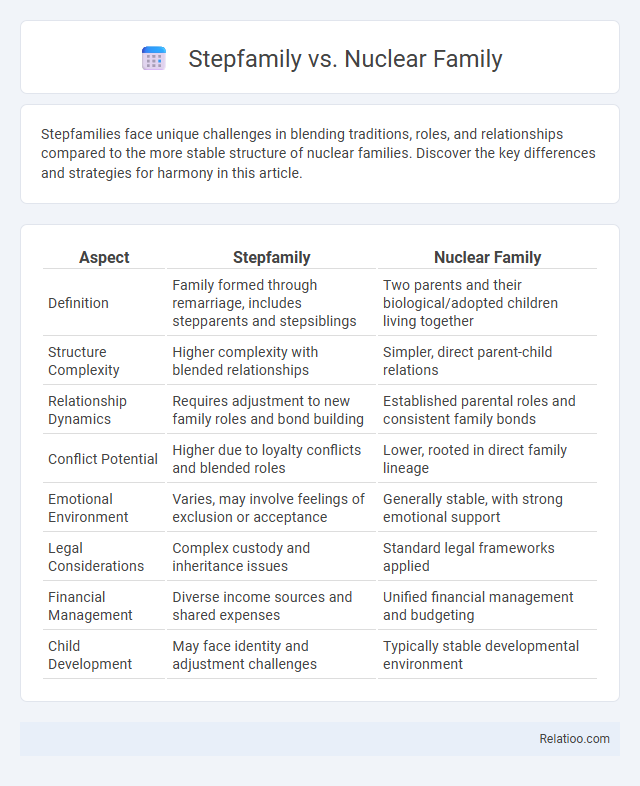Stepfamilies face unique challenges in blending traditions, roles, and relationships compared to the more stable structure of nuclear families. Discover the key differences and strategies for harmony in this article.
Table of Comparison
| Aspect | Stepfamily | Nuclear Family |
|---|---|---|
| Definition | Family formed through remarriage, includes stepparents and stepsiblings | Two parents and their biological/adopted children living together |
| Structure Complexity | Higher complexity with blended relationships | Simpler, direct parent-child relations |
| Relationship Dynamics | Requires adjustment to new family roles and bond building | Established parental roles and consistent family bonds |
| Conflict Potential | Higher due to loyalty conflicts and blended roles | Lower, rooted in direct family lineage |
| Emotional Environment | Varies, may involve feelings of exclusion or acceptance | Generally stable, with strong emotional support |
| Legal Considerations | Complex custody and inheritance issues | Standard legal frameworks applied |
| Financial Management | Diverse income sources and shared expenses | Unified financial management and budgeting |
| Child Development | May face identity and adjustment challenges | Typically stable developmental environment |
Understanding Stepfamilies and Nuclear Families
Stepfamilies consist of individuals where one or both partners have children from previous relationships, creating a blended family dynamic distinct from nuclear families, which typically include two parents and their biological or adopted children. Understanding stepfamilies involves recognizing unique challenges such as role ambiguity, loyalty conflicts, and the need for effective communication to build trust and cohesion. Nuclear families often benefit from more traditional role clarity and established routines, while stepfamilies require intentional strategies to integrate diverse family members and develop a shared family identity.
Key Differences in Family Structure
Stepfamily, nuclear family, and blended family differ primarily in their composition and relationship dynamics. A nuclear family consists of two biological parents and their children living together, while a stepfamily includes one biological parent, their children, and a new spouse or partner forming a blended household. Understanding these key differences in family structure helps you navigate the unique challenges and strengths present in each family type.
Parenting Roles and Responsibilities
Parenting roles in nuclear families typically involve clear biological ties where responsibilities for child-rearing are shared between two parents maintaining consistent routines and authority. In stepfamilies, parenting roles often require negotiation and adaptation to blended family dynamics, balancing biological parents' involvement with stepparents' developing authority and emotional bonds. Responsibilities in these family types emphasize communication, flexibility, and establishing trust to ensure children's stability and well-being amidst diverse family structures.
Emotional Dynamics and Relationships
Stepfamily relationships often involve complex emotional dynamics due to blending different family cultures and histories, requiring effective communication and boundaries to foster trust and cohesion. Nuclear families typically experience more straightforward emotional interactions, as members usually share common experiences and consistent parenting roles, promoting stable attachment and predictability. Understanding these differences helps you navigate emotional challenges and strengthen bonds within your unique family structure.
Communication Patterns in Each Family Type
Stepfamilies often face complex communication patterns due to blending different family cultures, requiring open dialogue to build trust and address conflicts. Nuclear families typically benefit from more consistent communication routines and clearer role expectations, promoting stable emotional support. Stepfamilies can develop unique communication strategies that balance loyalty, boundaries, and cooperation among biological and stepparents, enhancing family cohesion over time.
Challenges Unique to Stepfamilies
Challenges unique to stepfamilies include navigating complex relationships, such as building trust between stepparents and stepchildren while blending different family dynamics. Unlike nuclear families, stepfamilies often face legal and emotional hurdles related to custody, loyalty conflicts, and establishing consistent parenting roles. Your ability to foster open communication and patience is critical to overcoming these distinctive challenges and creating a cohesive family unit.
Strengths of Nuclear Families
Nuclear families offer stability through consistent parental roles and close-knit relationships that foster emotional security and effective communication among members. Their cohesive structure supports streamlined decision-making and balanced responsibilities, enhancing child development and socialization. Access to shared resources and unified values contributes to a nurturing environment that promotes resilience and well-being.
Blending Traditions and Values
Blending traditions and values presents unique challenges and opportunities within stepfamilies compared to nuclear families, where shared history often creates a unified cultural foundation. You can foster harmony in stepfamilies by openly communicating and respecting each member's background, creating new rituals that honor both original family values and new blended ones. Emphasizing flexibility and inclusion helps integrate diverse traditions into a cohesive family identity, enhancing emotional bonds and stability.
Child Adjustment and Development
Child adjustment and development vary significantly between stepfamilies and nuclear families due to differing family dynamics and stability. In nuclear families, consistent parenting and fewer transitions often support smoother emotional and social development. Your child's adaptability in stepfamilies may face challenges such as integrating new parental figures and navigating complex relationships, requiring targeted support to foster resilience and positive outcomes.
Support Systems and Coping Strategies
Stepfamily support systems often include blended family members and external networks to address unique challenges such as role ambiguity and loyalty conflicts, while nuclear families primarily rely on biological members for emotional and practical support. Your coping strategies in stepfamilies may emphasize boundary-setting and open communication to navigate complex relationships, whereas nuclear families typically focus on established routines and stable communication patterns. Understanding these distinctions helps tailor effective support and coping mechanisms that reflect each family's structural dynamics and needs.

Infographic: Stepfamily vs Nuclear Family
 relatioo.com
relatioo.com